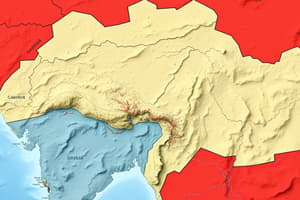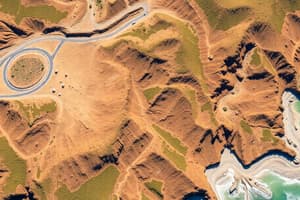Podcast
Questions and Answers
What is the primary mode of diffusion of the fashion trend of wearing socks on ears?
What is the primary mode of diffusion of the fashion trend of wearing socks on ears?
- Stimulus Diffusion
- Hierarchical Diffusion
- Expansion Diffusion (correct)
- Relocation Diffusion
What is the primary defining characteristic of a region?
What is the primary defining characteristic of a region?
- A region is defined by its strict adherence to specific physical characteristics.
- A region is defined solely by the cultural practices of its inhabitants.
- A region is defined by a combination of its physical and cultural traits, creating a distinct and unique identity. (correct)
- A region is defined by its political boundaries, as determined by governments.
Which of the following is NOT a characteristic of mental maps discussed in the text?
Which of the following is NOT a characteristic of mental maps discussed in the text?
- They are objective representations of reality (correct)
- They are unique to each individual
- They reflect personal understandings of space
- They are influenced by personal perceptions and experiences
What does the concept of 'scale' refer to in human geography?
What does the concept of 'scale' refer to in human geography?
What is the primary purpose of mental maps?
What is the primary purpose of mental maps?
How does the text suggest studying and understanding new geographic concepts?
How does the text suggest studying and understanding new geographic concepts?
Which of the following is a potential criterion for defining a region?
Which of the following is a potential criterion for defining a region?
What is the most likely reason the text suggests asking children to draw their neighborhood?
What is the most likely reason the text suggests asking children to draw their neighborhood?
How does the concept of 'regionalism' relate to the idea of 'scale'?
How does the concept of 'regionalism' relate to the idea of 'scale'?
What is meant by the idea of 'mental maps'?
What is meant by the idea of 'mental maps'?
What are the two main forms of diffusion discussed in the content?
What are the two main forms of diffusion discussed in the content?
What is the key characteristic of relocation diffusion?
What is the key characteristic of relocation diffusion?
What is a cultural landscape?
What is a cultural landscape?
What is an example of cultural landscape modification?
What is an example of cultural landscape modification?
According to the content, how do cultural groups imprint themselves on the landscape?
According to the content, how do cultural groups imprint themselves on the landscape?
What is an example of contagious diffusion?
What is an example of contagious diffusion?
What is the difference between Hierarchical and Contagious diffusion?
What is the difference between Hierarchical and Contagious diffusion?
Which of the following best exemplifies the impact of cultural landscape modification?
Which of the following best exemplifies the impact of cultural landscape modification?
Flashcards
Expansion diffusion
Expansion diffusion
The process by which a trend spreads from its origin to surrounding areas.
Mental maps
Mental maps
Personal representations of one’s understanding of space and place, shaped by individual perception.
Absolute vs. relative conceptualizations
Absolute vs. relative conceptualizations
Absolute refers to fixed locations; relative pertains to relationships between places.
Children’s perceptions of environment
Children’s perceptions of environment
Signup and view all the flashcards
Cultural influence on mental maps
Cultural influence on mental maps
Signup and view all the flashcards
Poor Body Image
Poor Body Image
Signup and view all the flashcards
Cultural Landscape
Cultural Landscape
Signup and view all the flashcards
Diffusion
Diffusion
Signup and view all the flashcards
Relocation Diffusion
Relocation Diffusion
Signup and view all the flashcards
Hierarchical Diffusion
Hierarchical Diffusion
Signup and view all the flashcards
Contagious Diffusion
Contagious Diffusion
Signup and view all the flashcards
Cultural Group Influence
Cultural Group Influence
Signup and view all the flashcards
Region
Region
Signup and view all the flashcards
Internal homogeneity
Internal homogeneity
Signup and view all the flashcards
Heterogeneous
Heterogeneous
Signup and view all the flashcards
Scale
Scale
Signup and view all the flashcards
Policymaker's perspective
Policymaker's perspective
Signup and view all the flashcards
Study Notes
Key Concepts in Human Geography II
- Human geography examines society, culture, and environment.
- The concepts of regions, landscapes, diffusion, and mental maps are crucial parts of this study.
- Regions are areas with internal similarities but possibly different from surrounding areas.
- Criteria for defining regions can be human/cultural (how people live) or physical, or a combination of both.
- A region is a distinct part of the world's surface, different from the rest of the world.
- The United States can be divided geographically, with different regions based on climate characteristics like cool, temperate, hot-arid, and hot-humid.
- Other countries also have distinct regions, like China, India, and the United Kingdom.
- Scale is a way to understand how society operates at different levels, ranging from global to household.
- Policymakers use various scales to address issues and problems.
Landscape
- Landscapes are visible features of land or area.
- Landscapes can be natural (physical) or a mix of human and natural elements.
- Landscapes are used to differentiate regions.
Cultural Landscape
- Cultural landscapes are a result of interactions between people and their environments.
- Each cultural group has a visible impact on the landscape.
- South-Western Ontario is an example to analyze cultural landscapes.
- Cultural groups modify landscapes to meet their specific needs.
- The modifications can be subtle or extensive.
Diffusion
- Diffusion is the spread of phenomena (like ideas or trends) across space and time.
- Diffusion can come from culture or health.
- Two types of diffusion are relocation and expansion.
Relocation Diffusion
- Relocation diffusion involves the physical movement of people.
- Immigration is an example of relocation diffusion.
- People moving to new regions bring and share their culture (language, attitudes, beliefs, food, dress, religion, customs, pastimes).
- Examples of groups who have diffused their culture via relocation are 19th-20th century British, Irish, and Scottish immigrants to Canada, post-war Italian, Greek, Serbian, and Polish immigrants to Canada, 21st century immigrants to Canada from Pakistan, China, India, and Bangladesh, etc.
Expansion Diffusion
- Expansion diffusion does not require people to relocate.
- Two types: hierarchical and contagious.
- Hierarchical diffusion moves "leapfrog" style from places of importance (key individuals, cities) to others, while the "leaping" might skip over some places.
- Contagious diffusion rapidly spreads throughout an area, moving outward from the center.
- An example of a new trend spreading via expansion diffusion, using the internet, is the wearing of socks on one's ears.
Mental Maps
- Mental maps represent a person's unique view of reality.
- They reflect personal perceptions and experiences of space.
- Mental maps are not objective representations of reality.
- They are personal and subjective.
- Mental maps display things differently depending on who you ask.
- Mental maps differ even within people from the same cultural background and area. This means a child's mental map will differ from an adult's mental map of the same place.
- Children's cultures influence their perception of their environments.
Studying That Suits You
Use AI to generate personalized quizzes and flashcards to suit your learning preferences.




